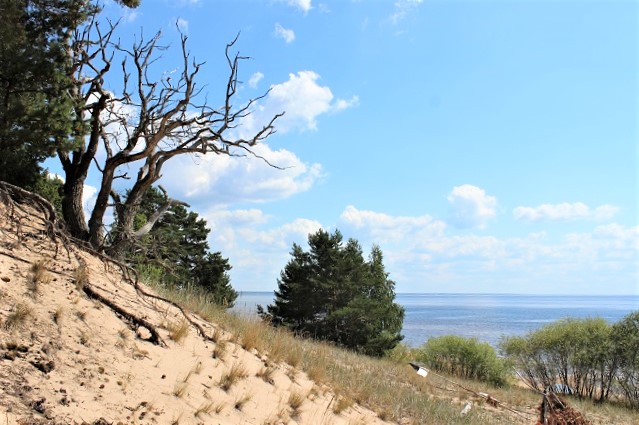
Dunes in Smolnitsa
The Smolnitsa Landscape Protection Area (250.6 ha) aims at the protection of the unique dunes of different ages on the northern shore of Lake Peipsi and their varied plant communities.This protected area, approximately 7 km in length and only 200–650 m in width, is a part of the Natura 2000 network and Alutaguse National Park.

Photo by Anne-Ly Feršel
The dunes, 5–12 m high, are covered with sparse plant vegetation, mosses, lichens, and shrubs. There is plenty of loose sand, unfixed with vegetation. There are damp hollows between the dune ridges. Behind the dunes, there are fens and about a-hundred-year-old paludified or still paludifying deciduous forests, e.g. birch forests with the Carex, which have a very high nature protectional value. The stagshorn clubmoss (Lycopodium clavatum) and several orchids are the protected species growing here.
The Smolnitsa Village has been named after production of tar (in Russian “smola”).
A fragmentary range of dunes, approximately 32 km in length and up to 1 km in width, covered with a pine forest, reaches from Rannapungerja to Vasknarva along the northern shore of Lake Peipsi. The dune ridge came into being at the withdrawal of Lake Peipsi. Its height is mostly 5–8 m but at Alajõe even up to 20 m. Water is stuck between and behind the dunes, which has caused the formation of fen communities. On the white dunes (the dunes outside the wave zone) some single plants, such as the sea lyme grass (Leymus arenarius), willows and the woolly butterbur (Petasites spurius) grow. The grey dunes with different species of moss and lichen, forming eventually pine forests, are followed. The lower and damper slope of the dunes is covered with plants faster than the high and dry middle part where the loose sand is blown away by wind. The very unique environment of the dunes offers habitats for some insects with interesting ways of life, such as the antlion (Myrmeleon formicarius) and the Sphecidae. Trampling on the dunes may destroy the vegetation, and cause sand drift and erosion. On the northern shore of Lake Peipsi, the friction of sand grain against grain produces a unique sound. “Singing sands” prove that the beach and lake water have not yet fully contaminated with salts, oils and washing detergents.
- Right of way: you can pass through and stay on private land from sunrise to sunset without causing disturbance to the owner or damage to the property.
- If the private property is fenced or posted against trespassing, the landlord’s permission is necessary.
- You can use a propelled floating craft to move on Lake Peipus.
- It is permitted to drive your motor vehicle on public roads and pathways. Parking is allowed within designated parking areas.
- Here is is not allowed camping and making fires.
- Please make sure no detergents enter natural water bodies
- Please use appropriate toilet facilities
- Please keep your pets under control and on leads at all times, they are a threat to wild life.
- Picking up wild berries, mushrooms and flowers etc is allowed, unless it is a protected species.
- Do not desecrate the natural beauty of the area
- Please report any damage or theft you may witness to the natural habitat to this area to 1313 (Environmental Information)
More informations: loodusega koos , visit estonia